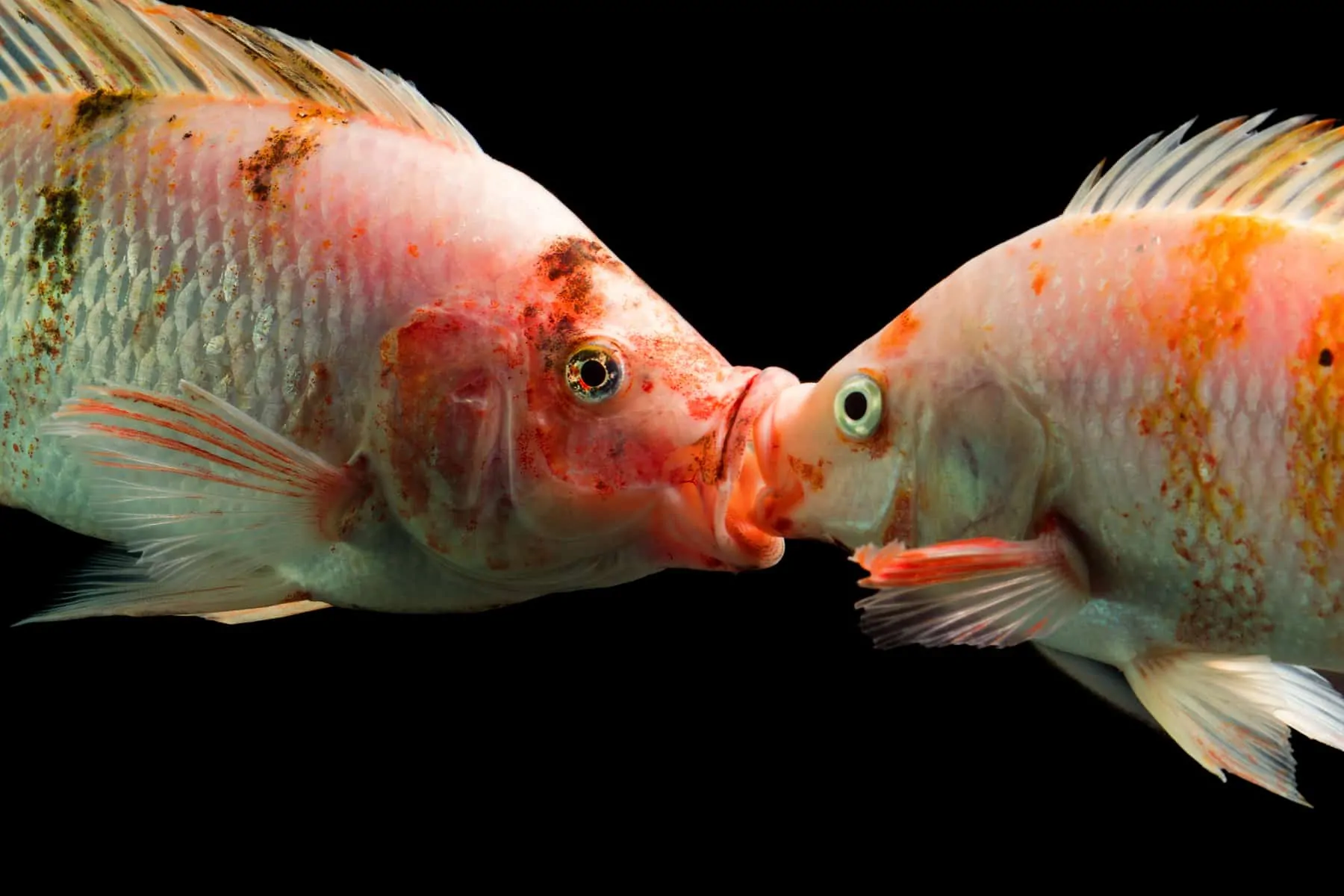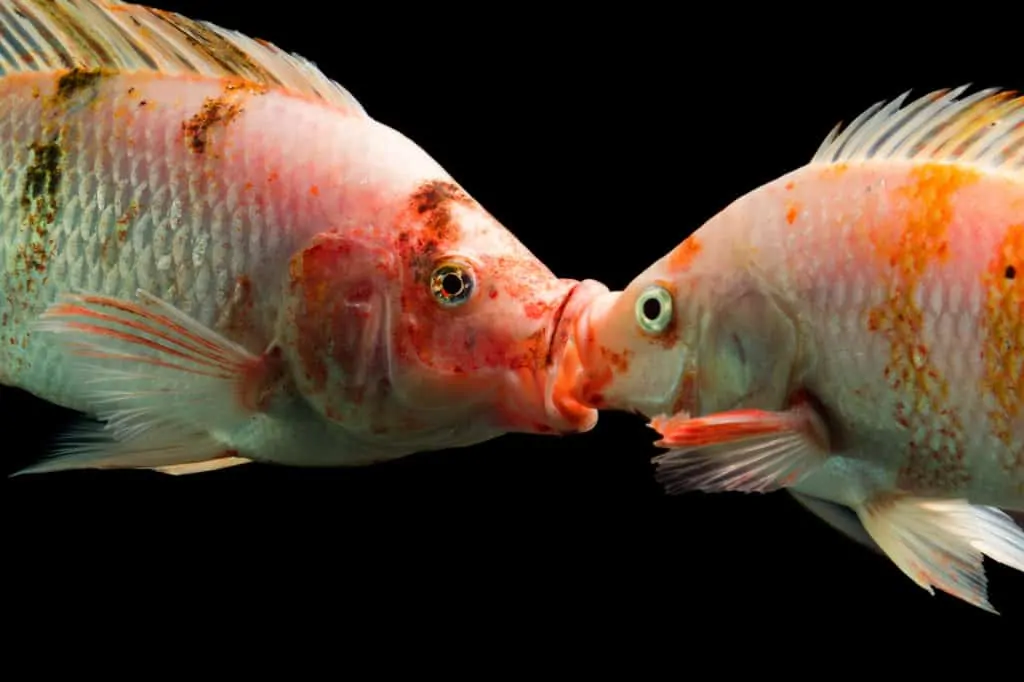If you’re a keen hobbyist, you may have considered breeding from your stock. Many fishkeepers, especially betta enthusiasts, enjoy studying the genetics of a particular species and trying to create new and exciting variations of the fish.
In this guide, we take a look at how fish mate, different reproductive strategies, and reproductive behavior. You may be surprised by what you learn!
Key Takeaways
- Fish reproductive behavior varies widely among species, with some bearing live young and others laying eggs. Techniques range from internal fertilization by livebearers to external egg laying by oviparous fish and even self-fertilization in hermaphroditic species.
- Environmental cues like water temperature or abundance of food can trigger fish breeding behavior, with many species having specific mating seasons, while others can reproduce year-round.
- For aquarium enthusiasts interested in breeding, livebearers like guppies are recommended as they are easy to breed and can offer an engaging venture into the fish breeding hobby.
Fish Reproductive System
Before we look at the different ways in which fish mate and their reproductive strategies, it’s important to understand the fish’s reproductive anatomy.
Like most vertebrates, an egg and sperm must combine to create new life. Although there are several ways in which that can happen, the common denominator is the fish’s reproductive organs: the testes and ovaries.
Most fish are dioecious, which means that the sexes are separate in that males have testes and females have ovaries. In some species, individuals contain both sets of organs, and these fish are called hermaphrodites. Some species of fish have secondary reproductive organs called the genital papilla. These are small fleshy tubes located at the back of the fish’s anal fin, and it’s from here that sperm is released.
Reproduction Classifications
Three primary classifications of reproductive methods apply to fish:
- Oviparity
- Ovoviviparity
- Viviparity
Oviparity
Like insects, reptiles, and birds, in oviparous fish, the fry embryo develops within the egg. However, unlike internal fertilization, that process takes place outside of the parent fish’s body.
An estimated 90 percent of fish are classified as oviparous reproducers. The female fish lays eggs, which the male then fertilizes. Most females lay many eggs at one spawning, and the number of eggs is referred to as “fecundity.”
The fish’s fecundity is very much dependent on the size of the fish. For example, the Silver Arowana may lay between 50 and 250 eggs per season, whereas the huge Ocean Sunfish releases anywhere up to 300 million!
Fertilization takes place in two main ways.
- the male releases his sperm directly onto the eggs
- The male releases sperm into the water, where it meets the eggs in the zooplankton layer
Oviparous fish fall into one of several categories:
Mouthbrooders
In mouthbrooders, the female fish lay their eggs in the water, where the male fertilizes them. The eggs are then collected by one of the parents and held in the fish’s mouth until they hatch. Interestingly, it’s often the male fish that carries out brooding duties, although, in some species, both the male and female fish play an equal role in raising the family.
In some species, as the fry grow, although they are free-swimming, they seek refuge in the parent fish’s mouth until they are large enough to fend for themselves.
Nest Builders
Some species of fish build a nest to keep their eggs safe and protected from predators until they hatch. In general, the nest is built by the male. The female inspects the male’s handiwork, and then, if she’s satisfied, she deposits her eggs in the nest, where the male fertilizes them.
Nests are sometimes made from bubbles, as with bettas. A nest can also be made from leaves, or it may be just a simple scrape in the substrate. Again, the male fish will fertilize the eggs by spraying his sperm over them.
I once owned a pair of Kribensis that spawned in my community tank. Their behavior was fascinating to watch! The female dug a scrape in the gravel underneath an upturned plant pot, creating a cozy den. She disappeared inside the den before emerging a week or so later, accompanied by a small shoal of tiny fry! The parent fish escorted their babies around the tank, with the male fending off all-comers who might want to eat his babies.
If you want to try your hand at breeding fish, bettas are a good place to start. As Reddit contributor, Gooroc points out in her post, you can even make a bit of spare cash from your hobby if you’re successful. Mind you, breeding good quality betta fish is a pretty full-on hobby that you should only attempt if you have the necessary time and facilities.
Egg Scatterers
Egg scatterers lay their eggs either in open water or somewhere undercover, where the eggs adhere to surfaces. The male fish swims through the carpet of eggs, depositing semen as he does so.
Egg Depositors
The female lays her eggs in one spot, and the male fish then swims over the eggs and fertilizes them.
Egg Buriers
Egg buriers hide their eggs in the substrate. The male fish then dives down into the substrate and fertilizes the eggs.
Ovoviviparous and Viviparous Fish
Both these categories of fish are more commonly called livebearers.
In livebearers, both the fertilization and development of the babies happen inside their mother. The female carries the eggs inside her body. The male uses his modified anal fin (gonopodium) to deposit sperm into the female’s body.
In ovoviviparous fish, the young develop inside the mother’s body, although she does not provide them with any nutrition. Instead, the youngsters use their egg’s yolk sac to feed on as they develop.
In viviparous fish, such as swordtails and guppies, the eggs are fertilized inside their mother’s body, where they develop. However, the growing embryos receive nourishment from their mother via a placenta-like structure that attaches the embryo to the mother fish.
In both cases, when development is complete, the mother gives birth to fully-formed live fry. In most fish, this process takes between two to four weeks. Examples of livebearing species include guppies and platys.
Once the female has mated and produced fry, she doesn’t always need to mate again to give birth. Some fish have been known to reproduce regularly without a male even being present.
If you want to try breeding fish in your aquarium, livebearers are often the easiest place to start.
Synchronous Hermaphrodites
Hermaphrodites are fish that carry both female and male reproductive parts within their bodies and can produce both sperm and eggs simultaneously.
These synchronous hermaphrodites can cross-fertilize to reproduce without any interaction with another fish of the opposite sex. Mangrove killifish is a good example of true hermaphrodites.
Sequential Hermaphrodites
Some hermaphrodites undergo a weird phenomenon called “sequential hermaphroditism.” Sequential hermaphrodites may be born male or female but can change to the opposite sex as they mature.
When a female hermaphroditic fish changes gender to become a male, the process is called “protogyny,” whereas the transformation of a male fish into a female is known as “protandry.”
Sequential hermaphrodites still need a fish of the opposite gender to reproduce.
So, what causes the switch in gender?
Well, sometimes, the change in gender orientation is caused by the prevailing conditions. For example, where a group of hermaphroditic fishes is deprived of the opposite sex, one of the groups may switch genders. A great example of that is the Clownfish.
A school of Clownfish often includes one male and one female as a mated pair. The remainder of the shoal will be made up of small males. If the female leaves the group or dies, the male will change gender to become female, and the next largest male fish in the school will become the new female’s replacement partner.
How Do Fish Mate?

Now that you understand more about the physical process of fish breeding, we’ll talk some more about some other aspects of fish reproduction and answer some of the most commonly asked questions about fish mating behavior.
At What Age Can Fish Mate?
In fish, the reproductive organs are usually the slowest part of the creature to develop. That’s because the sex organs are not essential for the fish’s survival at and immediately after birth.
Different fish species reach sexual maturity at different ages. That typically depends on the size and age of the fish and the individual species. As a general rule of thumb, the smaller the adult fish, the sooner they will be mature enough to mate. So, some species can mate within weeks of hatching from the egg, whereas others take many years to become sexually mature enough to breed.
What Are Mating Seasons?
When fish mate depends on the species.
Some fish can reproduce many times throughout the year regardless of the season, for example, Guppies, Mollies, Clownfish, Swordtails, and Platys.
Other fish are only able to reproduce during a particular season of the year when the water temperature is right or when there is ample food available to bring the fish into breeding condition.
Some fish only reproduce once and die shortly after they have spawned, for example, the Pacific salmon.
Most wild species mate in spring when the water becomes warmer and the daylight hours are longer. So, you can stimulate your fish to spawn by replicating those conditions in your home aquarium.
Who Knew?
Just when you thought we’d told you everything that you need to know about the different ways in which fish mate, here are a few fascinating facts that you can use to astound your friends!
- Spawning sardines off the South African coast produce a “slick” of eggs and sperm that is visible from the air.
- Male fish flirt with other males to attract females.
- Some Killifish species produce fertilized eggs that can still hatch even after they’ve dried out completely during a drought.
- The freshwater Gar produces eggs that are highly toxic if eaten!
- The Splashing Tetra leaps from the water to deposit its fertilized eggs on the leaves of an overhanging tree. The fish then splashes the eggs with warm water to keep them moist. When the eggs hatch, the fry drops into the water, fully formed and ready to go.
Final Thoughts
So, you can see that the question, “How do fish mate” has many answers!
There are many variations of breeding in fishes. But in a nutshell, in some species, the male fish inseminates the female fish who then grows the fry inside her body, other fish lay eggs, which are then fertilized by the male outside of the female’s body, and there are a few hermaphrodites self-fertilize, without the need for mating at all.
If you want to try breeding fish, there are plenty of aquarium species that are pretty straightforward to breed. We suggest that you begin with livebearers, such as guppies that seem to spend much of their time reproducing! As you become more experienced, you may want to try rearing other, more challenging species.
The mating and courtship rituals of many species are fascinating to watch, especially if the parents take an active role in rearing their young, such as Kribensis. However, before embarking on your new project, you must take the time to research the preferred tank conditions that are required by the fish species you want to breed.


